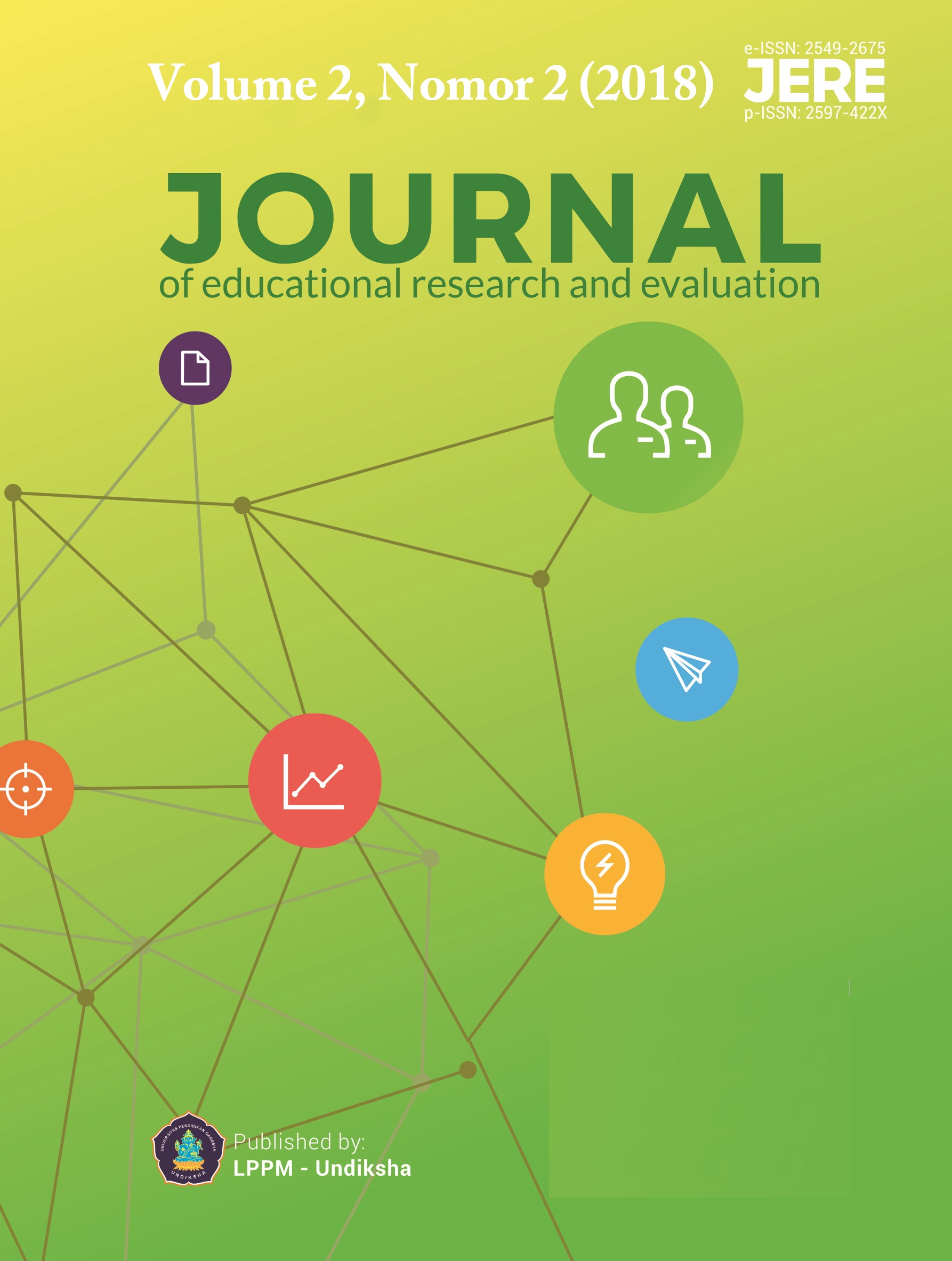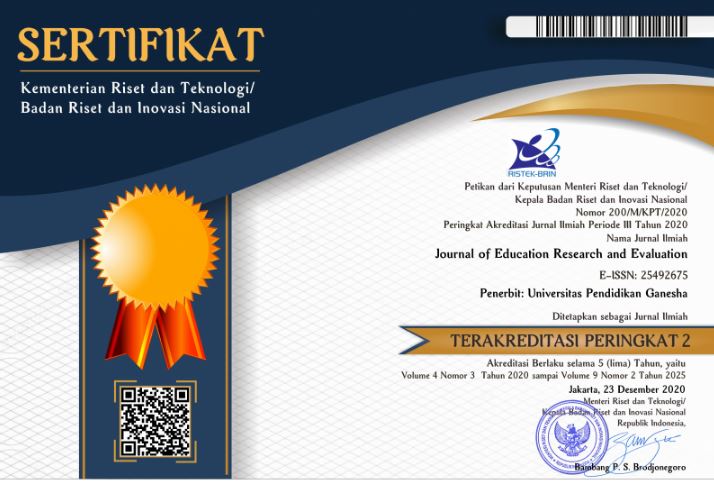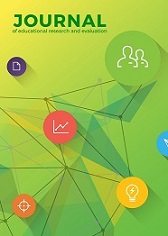THE REFUTATION TEXT IN POE TO REDUCE THE QUANTITY OF STUDENTS’ MISCONCEPTION
DOI:
https://doi.org/10.23887/jere.v2i2.12992Kata Kunci:
Refutation text, Reduce, quantity of students’ misconceptionAbstrak
The aim of this paper is to know the decreasing of the quantity student’s misconceptions after given a Refutation Text in Predict-Observe-Explain (POE) learning model by researcher. The hydrostatic pressure misconceptions consist of four sub-misconceptions. This research is a quantitative research with weak experimental design. Sampling technique applied purposive sampling and has involve 32 students on 9th grade of junior high school in Pandeglang, Banten, Indonesia. The diagnostic test is a multiple-choice form with three-tier test (TTT) format. The result of this research founded that there are decreasing of the quantity of student’s misconception on the hydrostatic pressure. The largest percentage decreasing of the quantity of student’s misconception is on the misconceptions 1 about 79.31%. Misconceptions 1 is the magnitude of Hydrostatic Pressure inversely proportional to it area surface. For the future research, suggested to combine strategies or methods for optimal decreasing the quantity of student’s misconceptionsReferensi
Acar Sesen, B. (2013). Diagnosing pre-service science teachers’ understanding of chemistry concepts by using computer-mediated predict–observe–explain tasks. Chem. Educ. Res. Pract., 14(3), 239–246. https://doi.org/10.1039/C3RP20143K
Akpinar, M., & Tan, M. (2011). Developing , Implementing , and Testing a Conceptual. In Western Anatolia Journal of Educational Science (pp. 139–144). Retrieved from http://webb.deu.edu.tr/baed/giris/baed/ozel_sayi/139-144.pdf
Broughton, S. H., Sinatra, G. M., & Reynolds, R. E. (2010). The nature of the refutation text effect: An investigation of attention allocation. Journal of Educational Research, 103(6), 407–423. https://doi.org/10.1080/00220670903383101
Chen, Y. L., Pan, P. R., Sung, Y. T., & Chang, K. E. (2013). Correcting misconceptions on electronics: Effects of a simulation-based learning environment backed by a conceptual change model. Educational Technology and Society, 16(2), 212–227. https://doi.org/10.1.1.299.6895
Fraenkel. J.R & Wallen, N.E. (2008). How to Design and Evaluate Research in Education. Seventh Edition. New York: Mc. Graw Hill.
Kurniawan, Y., Suhandi, A., & Hasanah, L. (2016). The influence of implementation of interactive lecture demonstrations (ILD) conceptual change oriented toward the decreasing of the quantity students that misconception on the Newton’s first law. AIP Conference Proceedings, 1708(Ild). https://doi.org/10.1063/1.4941180
Kurt, S., & Ayas, A. (2012). Improving students’ understanding and explaining real life problems on concepts of reaction rate by using a four step constructivist approach. Energy Education Science and Technology Part B: Social and Educational Studies, 4(2), 979–992.
Muliyani, R., & Kaniawati, I. (2015). Identification of Quantity Students ’ Misconceptions on Hydrostatic Pressure with Three Tier-Test. In FULL PAPER PROCEEDING GTAR- 2015 (Vol. 2, pp. 716–720).
Pourhosein Gilakjani, A. (2011). Visual, Auditory, Kinaesthetic Learning Styles and Their Impacts on English Language Teaching. Journal of Studies in Education, 2(1), 104. https://doi.org/10.5296/jse.v2i1.1007
Pratiwi, A., & Wasis. (2013). PEMBELAJARAN DENGAN PRAKTIKUM SEDERHANA UNTUK MEREDUKSI MISKONSEPSI SISWA PADA MATERI FLUIDA STATIS DI KELAS XI SMA NEGERI 2 TUBAN. Jurnal Inovasi Pendidikan Fisika, 2(3), 117–120
Treagust D.F., Mthembu Z., Chandrasegaran A.L. (2014). Evaluation of the Predict-Observe-Explain Instructional Strategy to Enhance Students’ Understanding of Redox Reactions. In: Devetak I., Glažar S. (eds) Learning with Understanding in the Chemistry Classroom. Springer, Dordrecht.
Unduhan
Diterbitkan
Cara Mengutip
Terbitan
Bagian
Lisensi
Authors who publish with the Journal of Evaluation and Research in Education (JERE) agree to the following terms:
- Authors retain copyright and grant the journal the right of first publication with the work simultaneously licensed under a Creative Commons Attribution License (CC BY-SA 4.0) that allows others to share the work with an acknowledgment of the work's authorship and initial publication in this journal.
- Authors are able to enter into separate, additional contractual arrangements for the non-exclusive distribution of the journal's published version of the work (e.g., post it to an institutional repository or publish it in a book), with an acknowledgment of its initial publication in this journal.
- Authors are permitted and encouraged to post their work online (e.g., in institutional repositories or on their website) prior to and during the submission process, as it can lead to productive exchanges, as well as earlier and greater citation of published work. (See The Effect of Open Access)











